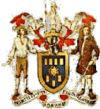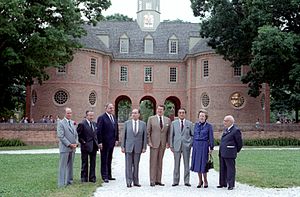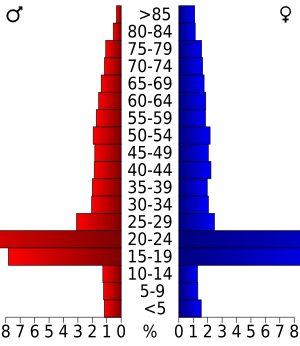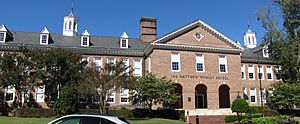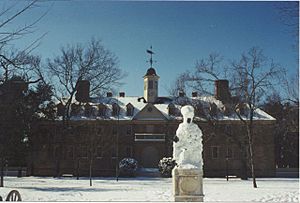Williamsburg, Virginia facts for kids
Quick facts for kids
Williamsburg
|
|||||
|---|---|---|---|---|---|
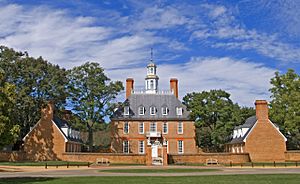
The Williamsburg Governor's Palace in 2012
|
|||||
|
|||||
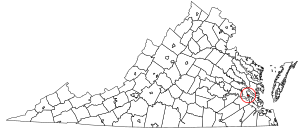
Location in the Commonwealth of Virginia
|
|||||
| Country | United States | ||||
| State | Virginia | ||||
| Founded | 1632 | ||||
| Named for | William III of England | ||||
| Area | |||||
| • Total | 9.10 sq mi (23.57 km2) | ||||
| • Land | 8.94 sq mi (23.15 km2) | ||||
| • Water | 0.16 sq mi (0.42 km2) | ||||
| Elevation | 82 ft (15 m) | ||||
| Population
(2020)
|
|||||
| • Total | 15,425 | ||||
| • Density | 1,695.1/sq mi (654.43/km2) | ||||
| Time zone | UTC−5 (EST) | ||||
| • Summer (DST) | UTC−4 (EDT) | ||||
| ZIP codes |
23185-23188
|
||||
| Area code(s) | 757, 948 | ||||
| FIPS code | 51-86160 | ||||
| GNIS feature ID | 1498551 | ||||
Williamsburg is a special kind of city in Virginia, United States. It's called an independent city because it's not part of any county. In 2020, about 15,425 people lived there.
Williamsburg is located on the Virginia Peninsula. It's part of the larger Hampton Roads area. The city is surrounded by James City County and York County.
English settlers started Williamsburg in 1632. They called it Middle Plantation. It was a safe, walled town built on high ground. This spot was between the James and York rivers. It was also further inland than their main settlement at Jamestown.
Williamsburg was the capital of the Colony and then the Commonwealth of Virginia from 1699 to 1780. It played a big role in events leading up to the American Revolution. The College of William & Mary was founded here in 1693. It's the second-oldest college in the United States. Many important people in early American history went to this college.
Today, Williamsburg's economy relies a lot on tourism. This is thanks to Colonial Williamsburg, a special area that has been restored to look like it did in the 1700s. Williamsburg, along with nearby Jamestown and Yorktown, forms the Historic Triangle. This area attracts over four million visitors every year. Williamsburg is also a college town, with many students and staff from William & Mary living there.
Contents
History of Williamsburg
How Williamsburg Began: The 1600s
Before English settlers arrived in 1607, the land where Williamsburg now stands belonged to the Powhatan Confederacy. By the 1630s, English towns were growing fast. The Powhatan tribes had moved away from their villages nearby.
Between 1630 and 1633, English colonists built a strong fence, called a palisade, across the peninsula. They also built a settlement called Middle Plantation. This was a main guard post along the palisade.
Jamestown, the first capital of Virginia, burned down in 1676 during Bacon's Rebellion. The government moved temporarily to Middle Plantation. People found this new spot safer and nicer than Jamestown, which was often hot and full of mosquitoes.
Colonists had long wanted a college. An earlier attempt failed because the location was not safe. In the 1690s, they tried again. Reverend James Blair worked hard in England to get a royal charter. The new school was named the College of William & Mary. It honored the king and queen at the time.
The college was founded in Middle Plantation in 1693. Classes started in 1694. Soon, construction began on the College Building, which is now the Wren Building.
In 1698, the rebuilt Statehouse in Jamestown burned down again by accident. The government moved back to Middle Plantation temporarily. They also used the college's buildings. In 1699, the college students asked the government to stay. Everyone agreed to make Middle Plantation the permanent capital.
The town was then planned out and renamed Williamsburg. This honored King William III of England.
Alexander Spotswood became lieutenant governor in 1710. He helped fill ravines and level streets. He also helped build more college buildings, a church, and a place to store weapons. In 1722, Williamsburg received a special "city incorporate" charter. This is believed to be the oldest city charter in the United States.
For most of the colonial period, the border between James City County and York County ran right down the middle of Duke of Gloucester Street.
Williamsburg in the 1700s
Even after Virginia became a state in 1776, Williamsburg was still split between two counties. This caused some problems.
Williamsburg was also the site of the first attempt to build a canal in the United States. In 1771, Lord Dunmore, Virginia's last Royal Governor, planned to connect two creeks. This would have created a water route across the Virginia Peninsula. The canal was never finished. You can still see parts of it behind the Governor's Palace in Colonial Williamsburg.
In the 1770s, the first hospital in the U.S. for people with mental health issues was built here. It was called the Public Hospital for Persons of Insane and Disordered Minds. Today, it's known as Eastern State Hospital. It opened in 1771 and could hold 24 patients.
The Gunpowder Incident happened in April 1775. This was a disagreement between Governor Dunmore and Virginia colonists. Dunmore ordered soldiers to take gunpowder from the Williamsburg storage building. Virginia militia, led by Patrick Henry, marched on Williamsburg. Dunmore threatened to destroy the city. The problem was solved when the colonists paid for the gunpowder. This event was an important step towards the American Revolution.
On July 25, 1776, the Declaration of Independence was announced in Williamsburg. People celebrated with cheers, cannon fire, and fireworks.
During the war, Virginia's capital moved again in 1780. Governor Thomas Jefferson wanted it in Richmond. He worried Williamsburg was too easy for the British to attack. Williamsburg still hosted many important meetings during the war.
After 1780, Williamsburg was no longer the capital. It became a quieter town. Travel by water was very important back then. Williamsburg was not on a major river, which made it less busy. Railroads also didn't reach the city until the 1830s.
Williamsburg in the 1800s
Even though Williamsburg lost its role as capital, the College of William and Mary continued to grow. The Public Hospital also expanded.
When the American Civil War (1861–1865) began, many students from the College of William and Mary joined the Confederate Army. The college closed in 1861. The College Building was used as a Confederate army barracks and then a hospital. Union forces burned it in 1862.
In the spring of 1862, Williamsburg saw fighting during the Peninsula Campaign. This was when Union forces tried to capture Richmond. Confederate General John B. Magruder tricked the Union army into thinking his forces were larger. This gave the Confederates time to build defenses around Richmond.
At the Battle of Williamsburg on May 5, 1862, Confederate forces delayed the Union army. This allowed the Confederates to reach Richmond's defenses. On May 6, 1862, Williamsburg fell to the Union. Union soldiers burned the College Building in September 1862. Williamsburg was damaged during the Union occupation, which lasted until 1865.

In 1881, the Chesapeake and Ohio Railway (C&O) built a railroad through Williamsburg. This was great for farmers and businesses. It made travel and shipping easier. The railroad tracks even went through the ruins of the old capitol building. Later, these tracks were moved.
The College of William and Mary continued thanks to President Benjamin S. Ewell. He worked hard to get funding from the U.S. Congress and Virginia. In 1888, the college received money to train teachers. In 1906, Virginia took ownership of the college buildings and became responsible for funding it.
In the 1890s, a C&O land agent named Carl M. Bergh helped many people from Norway, Sweden, and Denmark move to the area. They were farmers looking for a warmer climate. A place west of Williamsburg was even renamed Norge (which means Norway). These new residents helped the community grow.
Williamsburg in the 1900s
In the early 1900s, Williamsburg was a quiet, small town. Some people even called it "Lotusburg" because things moved so slowly.
However, an Episcopal priest named Dr. W. A. R. Goodwin had a big dream. He wanted to restore Williamsburg and turn it into a huge living museum. He first saved his own church, Bruton Parish Church. Then he saw that many other old colonial buildings were falling apart.
Goodwin found support from Standard Oil heir John D. Rockefeller Jr. and his wife Abby Aldrich Rockefeller. Together, they created Colonial Williamsburg. They restored much of downtown Williamsburg. This created a 301-acre Historic Area that celebrates early American history.
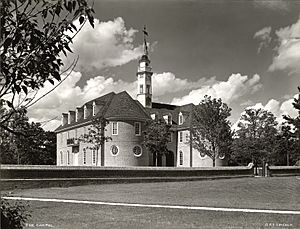
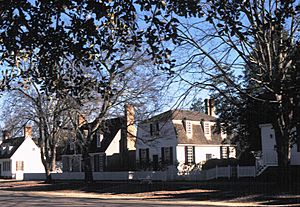
Today, Colonial Williamsburg is Virginia's biggest tourist attraction. It's a key part of the Historic Triangle with Jamestown and Yorktown. Colonial Williamsburg keeps adding new features. These include attractions for kids and better ways to share the history of Black Americans in the town.
The city's railroad station was also restored. It became a modern transportation center.
In 1932, a Catholic church was built for students at the College of William & Mary. This church, Old Saint Bede, became a special national shrine.
In 1976, a debate between President Gerald Ford and Jimmy Carter happened at the College of William & Mary. They both spoke about a "new spirit" in America.
The 9th G7 summit was held in Williamsburg in 1983. Leaders from seven major countries discussed world debt and arms control.
Williamsburg in the 2000s
On May 3, 2007, Britain's Queen Elizabeth II visited Jamestown and Williamsburg. She had visited Williamsburg before in 1957. Many world leaders, including President George W. Bush, came to Jamestown to celebrate its 400th anniversary.
On February 5, 2009, President Barack Obama made his first trip on Air Force One to Williamsburg. He attended a meeting for House Democrats there.
Geography of Williamsburg
Williamsburg covers about 9.1 square miles. Most of this is land, with a small amount of water.
The city sits on a ridge between the James and York Rivers. Two creeks, Queen's Creek and College Creek, partly surround the city. James City County is to the west and south. York County is to the north and east. Williamsburg is an independent city, so it's not part of either county.
The city is located near I-64. This highway connects Williamsburg to Richmond (about 45 miles northwest) and Norfolk (about 37 miles southeast). Williamsburg is in the northwest part of Hampton Roads, a large metropolitan area.
What is the Climate Like in Williamsburg?
Williamsburg has a humid subtropical climate. This means it has cool to mild winters and hot, humid summers. Snowfall is usually light, averaging about 4.3 inches per year. Summers tend to be a bit wetter. The highest temperature ever recorded was 104°F, and the lowest was -7°F.
| Climate data for Williamsburg, Virginia (1991–2020 normals, extremes 1951–present) | |||||||||||||
|---|---|---|---|---|---|---|---|---|---|---|---|---|---|
| Month | Jan | Feb | Mar | Apr | May | Jun | Jul | Aug | Sep | Oct | Nov | Dec | Year |
| Record high °F (°C) | 81 (27) |
83 (28) |
90 (32) |
96 (36) |
98 (37) |
104 (40) |
103 (39) |
104 (40) |
103 (39) |
96 (36) |
85 (29) |
82 (28) |
104 (40) |
| Mean daily maximum °F (°C) | 49.1 (9.5) |
52.3 (11.3) |
59.8 (15.4) |
70.0 (21.1) |
77.2 (25.1) |
84.4 (29.1) |
88.5 (31.4) |
86.5 (30.3) |
80.5 (26.9) |
71.0 (21.7) |
61.1 (16.2) |
52.6 (11.4) |
69.4 (20.8) |
| Daily mean °F (°C) | 39.8 (4.3) |
42.2 (5.7) |
49.1 (9.5) |
58.9 (14.9) |
67.1 (19.5) |
74.9 (23.8) |
79.3 (26.3) |
77.6 (25.3) |
71.8 (22.1) |
61.1 (16.2) |
51.0 (10.6) |
43.4 (6.3) |
59.7 (15.4) |
| Mean daily minimum °F (°C) | 30.6 (−0.8) |
32.0 (0.0) |
38.5 (3.6) |
47.7 (8.7) |
57.0 (13.9) |
65.3 (18.5) |
70.2 (21.2) |
68.7 (20.4) |
63.1 (17.3) |
51.3 (10.7) |
40.9 (4.9) |
34.1 (1.2) |
49.9 (9.9) |
| Record low °F (°C) | −7 (−22) |
1 (−17) |
10 (−12) |
22 (−6) |
31 (−1) |
37 (3) |
48 (9) |
44 (7) |
38 (3) |
21 (−6) |
15 (−9) |
0 (−18) |
−7 (−22) |
| Average precipitation inches (mm) | 3.77 (96) |
3.05 (77) |
4.25 (108) |
3.98 (101) |
3.89 (99) |
4.16 (106) |
5.92 (150) |
5.68 (144) |
5.40 (137) |
4.21 (107) |
3.13 (80) |
3.80 (97) |
51.24 (1,301) |
| Average snowfall inches (cm) | 1.7 (4.3) |
1.6 (4.1) |
0.2 (0.51) |
0.1 (0.25) |
0.0 (0.0) |
0.0 (0.0) |
0.0 (0.0) |
0.0 (0.0) |
0.0 (0.0) |
0.0 (0.0) |
0.0 (0.0) |
0.7 (1.8) |
4.3 (11) |
| Average precipitation days (≥ 0.01 in) | 10.6 | 9.7 | 10.6 | 10.3 | 11.3 | 10.7 | 12.0 | 10.8 | 10.2 | 8.8 | 9.1 | 10.6 | 124.7 |
| Average snowy days (≥ 0.1 in) | 0.5 | 0.6 | 0.2 | 0.0 | 0.0 | 0.0 | 0.0 | 0.0 | 0.0 | 0.0 | 0.0 | 0.3 | 1.6 |
| Source: NOAA | |||||||||||||
People Living in Williamsburg
| Historical population | |||
|---|---|---|---|
| Census | Pop. | %± | |
| 1820 | 1,402 | — | |
| 1850 | 877 | — | |
| 1860 | 1,113 | 26.9% | |
| 1870 | 1,392 | 25.1% | |
| 1880 | 1,480 | 6.3% | |
| 1890 | 1,831 | 23.7% | |
| 1900 | 2,044 | 11.6% | |
| 1910 | 2,714 | 32.8% | |
| 1920 | 2,462 | −9.3% | |
| 1930 | 3,778 | 53.5% | |
| 1940 | 3,942 | 4.3% | |
| 1950 | 6,735 | 70.9% | |
| 1960 | 6,832 | 1.4% | |
| 1970 | 9,069 | 32.7% | |
| 1980 | 9,870 | 8.8% | |
| 1990 | 11,530 | 16.8% | |
| 2000 | 11,998 | 4.1% | |
| 2010 | 14,068 | 17.3% | |
| 2020 | 15,425 | 9.6% | |
| U.S. Decennial Census 1790-1960 1900-1990 1990-2000 2010-2020 |
|||
During the time of the American Revolution, more than half of Williamsburg's population was African American.
In 2000, Williamsburg was about 78% White and 13% Black. By 2010, it was 71% White and 14% Black. The 2020 census showed a big change, with Williamsburg being 48% White and 37% Black. Researchers think this big change in the Black population might be due to how the census protects people's privacy.
Williamsburg's Population in 2020
| Race / Ethnicity | Pop 2000 | Pop 2010 | Pop 2020 | % 2000 | % 2010 | % 2020 |
|---|---|---|---|---|---|---|
| White alone (NH) | 9,352 | 9,952 | 7,370 | 77.95% | 70.74% | 47.78% |
| Black or African American alone (NH) | 1,593 | 1,918 | 5,648 | 13.28% | 13.63% | 36.62% |
| Native American or Alaska Native alone (NH) | 31 | 35 | 20 | 0.26% | 0.25% | 0.13% |
| Asian alone (NH) | 546 | 802 | 497 | 4.55% | 5.7% | 3.22% |
| Pacific Islander alone (NH) | 6 | 4 | 25 | 0.05% | 0.03% | 0.16% |
| Some Other Race alone (NH) | 15 | 23 | 53 | 0.13% | 0.16% | 0.34% |
| Mixed Race/Multi-Racial (NH) | 153 | 393 | 597 | 1.28% | 2.79% | 3.87% |
| Hispanic or Latino (any race) | 302 | 941 | 1,215 | 2.52% | 6.69% | 7.88% |
| Total | 11,998 | 14,068 | 15,425 | 100.00% | 100.00% | 100.00% |
Note: the US Census treats Hispanic/Latino as an ethnic category. This table excludes Latinos from the racial categories and assigns them to a separate category. Hispanics/Latinos can be of any race.
Williamsburg's Population in 2010
In 2010, there were 14,068 people living in Williamsburg. There were 3,619 households. About 16.5% of households had children under 18. About 37.2% were married couples.
The age breakdown was: 9.6% under 18, 46.0% from 18 to 24, 17.7% from 25 to 44, 15.0% from 45 to 64, and 11.7% who were 65 or older. The average age was 23 years. For every 100 females, there were about 81 males.
The average household income was $37,093. About 18.3% of the population lived below the poverty line. Many retirees move to Williamsburg. They often get income from investments.
Williamsburg's Economy

Because of Colonial Williamsburg, many businesses that serve tourists have come to the area. One big company was Anheuser-Busch. They built a large brewery nearby. They also used to own two theme parks: Busch Gardens Williamsburg and Water Country USA. These parks were later sold to other investors.
Williamsburg has an outlet mall called Williamsburg Premium Outlets. There used to be another one, but it closed. The Williamsburg Pottery Factory also has outlet stores.
Arts and Culture in Williamsburg
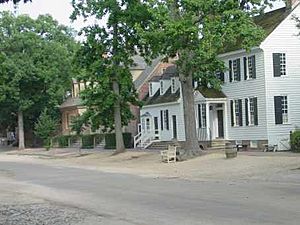
Williamsburg is part of the American South. People who grew up in the Hampton Roads area might have a unique "Tidewater accent." This accent sounds a bit different from a typical Southern accent.
Popular tourist spots include Colonial Williamsburg. This is a living history museum that shows what life was like in the 1700s. Here you can see Virginia's first capitol building, the Governor's Palace, and Bruton Parish Church. Bruton Parish Church is the oldest church in the U.S. that has been open continuously. You can also visit the Peyton Randolph House and The College of William & Mary.
Other places to visit are the Abby Aldrich Rockefeller Folk Art Museum, The Williamsburg Winery, and the Williamsburg Botanical Garden. Williamsburg also has two theme parks: Busch Gardens Williamsburg and Water Country USA. Presidents Park used to be an attraction with large statues of U.S. presidents. It closed in 2010.
Education in Williamsburg
The Williamsburg-James City County Public Schools district runs several schools in Williamsburg. These include Matthew Whaley School, Berkeley Middle School, James Blair Middle School, Lafayette High School, and Warhill High School.
There are also private schools in the area. These include Williamsburg Christian Academy, Walsingham Academy (a Catholic school), Williamsburg Montessori School, and Providence Classical School.
The College of William & Mary has been in Williamsburg since 1693. This makes it the second-oldest college in America. It was also the first U.S. school to get a special Royal Charter. The college campus is right next to the Historic District. The Wren Building was one of the first buildings restored by W. A. R. Goodwin and the Rockefeller family when they started Colonial Williamsburg. Over 70% of the college's students volunteer or work part-time in the community. They give over 300,000 hours of volunteer service each year.
Media in Williamsburg
Williamsburg has two main newspapers: The Virginia Gazette and Williamsburg-Yorktown Daily. The Gazette is published twice a week. It was the first newspaper published south of the Potomac River, starting in 1736.
The Daily Press, from nearby Newport News, also covers news for Williamsburg. The College of William & Mary has its own student newspapers, The Flat Hat and The Virginia Informer. Students also create other publications and run their own radio station, WCWM.
Transportation in Williamsburg

Williamsburg is close to Interstate 64 and U.S. Route 60. These roads connect the city to Richmond and Norfolk. State Route 199 goes around the city. The Colonial Parkway is a scenic road that connects Williamsburg to Jamestown and Yorktown.
The city's public bus system is called Williamsburg Area Transit Authority (WATA). It has a main hub at the transportation center. The buses serve Williamsburg and parts of James City County and York County. They run hourly, seven days a week. WATA also has special trolley buses for the Yorktown Riverfront.
Walking is a popular way to get around Williamsburg. About one-fifth of people walk to work. The city is also becoming more bicycle-friendly. It has built 48 miles of bike paths since 1992. The Virginia Capital Trail will soon offer a paved path for bikes and walkers all the way to Richmond.
The closest airport is the Newport News/Williamsburg International Airport. It's about a twenty-minute drive from Williamsburg. Amtrak trains also stop at the Amtrak Station three times a day. Greyhound buses offer intercity services.
Notable People from Williamsburg
- John Amson, a doctor and former mayor of Williamsburg.
- Brent Ashabranner, an author.
- Matt Behncke, a former professional soccer player.
- John Blair Jr., who signed the United States Constitution.
- Lemuel J. Bowden, a former U.S. Senator.
- Al Clark, a former professional baseball umpire.
- Jimmy Fortune, a singer from The Statler Brothers.
- Bruce Hornsby, a singer and keyboard player.
- Keith Hornsby, an NBA G League player and Bruce Hornsby's son.
- John Nicholas, a former U.S. Congressman.
- Robert C. Nicholas, a former New York State Senator.
- Robert Carter Nicholas Sr., a judge.
- Wilson Cary Nicholas, a former U.S. Senator.
- Edmund Randolph, the first U.S. Attorney General and a Governor of Virginia.
- Carolynn Reid-Wallace, an academic leader.
- Lawrence Taylor, a former football player for the New York Giants.
- Georgia O'Keeffe, a famous American painter.
- Canaan Smith, a country music artist.
- John Tayloe II, owner of Tayloe House.
- David Berman, a music artist.
|
See also
 In Spanish: Williamsburg (Virginia) para niños
In Spanish: Williamsburg (Virginia) para niños




